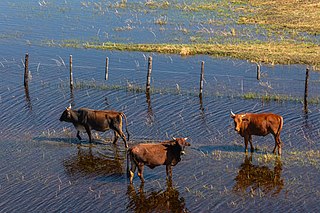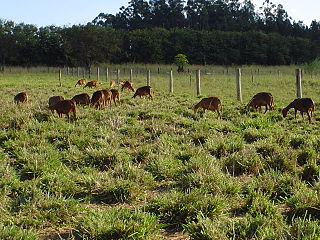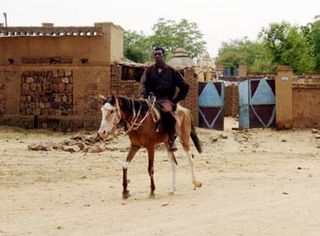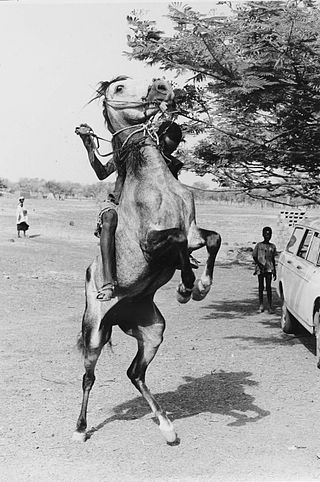Related Research Articles

The Charolais or Charolaise is a French breed of taurine beef cattle. It originates in, and is named for, the Charolais area surrounding Charolles, in the Saône-et-Loire department, in the Bourgogne-Franche-Comté region of eastern France.

The Kinsky Horse is a Czech breed of warmblood sport horse. It was bred by the Kinsky family in the Kingdom of Bohemia, and is now one of four warmblood sport horse breeds reared in the Czech Republic, the others being the Czech Warmblood, the Slovakian Warmblood and the Moravian Warmblood. It was for many years absorbed into the Czech Warmblood; a separate stud-book was established in 2005. It is characterised by an unusual golden-yellow coat, though other colours are also seen.
The Priob or Ob is an endangered Russian breed of small horse from the Khanty-Mansi Autonomous Okrug, in Tyumen Oblast in the Russian Federation. It is distributed in the area of the Irtysh and lower Ob Rivers in western Siberia, and is a traditional breed of the indigenous people of that area, who used it for agriculture, for draft work, for forestry, and as a pack-horse.

The Tswana is an indigenous breed or group of breeds of beef cattle of Botswana. It is a Sanga type, similar to Barotse and Tuli. The coat colour may be solid red or black, red pied or – less frequently – black pied. It is also present in South Africa. Animals of this breed are well adapted to hot, dry environments and have a high level of tick and heat tolerance.
The Indu-Brasil or Indo-Brazilian is a Brazilian breed of zebuine beef cattle. It was bred in the early twentieth century in the Triângulo Mineiro in the western part of Minas Gerais state, and particularly in the area surrounding Uberaba. It was originally known as the Induberaba. It derives from imported Indian zebuine cattle, principally Gir and Kankrej. It was formerly an important beef breed, but in the twenty-first century is an endangered breed. It is characterised by particularly large ears, perhaps the largest seen in any breed of cattle.

Kalmyk cattle is a breed of beef cattle of the former Soviet Union, now found in the Russian Federation, in Kazakhstan and in Tajikistan. It is believed to have originated in Dzungaria, and to have been brought into south-eastern Russia by migrating Kalmyks in the seventeenth century.

The Irish Goat is a traditional Irish breed of domestic goat. It is a dual-purpose breed, used both for meat and for milk. It is an endangered breed and may survive only in feral populations. It is distinct from the feral Bilberry Goat of Waterford.

Morada Nova is a Brazilian breed of domestic sheep. It originates in the state of Ceará, in Nordeste, the north-eastern region of Brazil, on the Atlantic coast.
The Vlaamperd is a South African breed of light draught or harness horse; it is also suitable for riding. It was bred in the Western Cape region of South Africa in the early twentieth century, and resulted from cross-breeding of local mares with imported European stallions, particularly Friesians. The horses are usually black, though mares may be dark seal brown. A stud-book was started in 1983.

Western Sudan Pony is an exonym for a Sudanese breed or group of breeds or ecotypes of small horse or pony. These are distributed principally in southern Darfur and south-western Kordofan, extending into southern Chad, and are known generically as Gharbaui ("western") or by a variety of regional names including Darfur Pony and Kordofani.
The Azerbaijan, is an Azerbaijani breed or group of breeds of riding horse of Oriental type. In 2007 it was listed by the FAO as endangered; in 2021 it was not among the horse breeds reported to DAD-IS.

The Dongola or Dongolawi is an African breed of riding horse. It is predominantly of Barb type, though there may have been some Arab influence in the past. It originated in the Dongola province of Sudan, for which it is named. In eastern Africa it is distributed in the northern part of Sudan and in western Eritrea; it is also present in several West African countries including Cameroon, Chad and the Central African Republic. A number of local West African breeds or types derive from it; they may be regarded as sub-types, or may be reported as separate breeds.

The Umblachery is an Indian breed of zebuine cattle. It is distributed in the coastal plains of the districts of Nagapattinam, Tiruvarur and Thanjavur in the state of Tamil Nadu in South India. It was bred for draught work, particularly in the rice paddies of the area.

The Swedish Red-and-White, Swedish: Svensk Röd och Vit Boskap, frequently abbreviated to SRB, is a Swedish breed of dairy cattle. It was created in the 1920s by crossing the Swedish Red Pied and Swedish Ayrshire breeds.
The Swedish Red Pied, Swedish: Rödbrokig Svensk Boskap, frequently abbreviated to RSB, was a Swedish breed of dairy cattle. It is now considered extinct. It was merged in the 1920s with the Swedish Ayrshire breed to create the Swedish Red-and-White, which is one of the principal dairy breeds of Sweden.

The Swedish Polled, Swedish: Svensk Kullig Boskap, often abbreviated to SKB, is a Swedish breed of domestic cattle. It was created in 1937 from two different Swedish cattle breeds, the Swedish Red Polled and the Fjäll. Breeders did not accept the new classification, and continued to maintain separate bloodlines as before. Of the two constituent breeds, the Swedish Red Polled received official recognition in 2004, while the Fjäll has divided into two sub-breeds, the Fjällnära Boskap and the Svensk Fjällras.
The Shan Horse or Shan Myinn is a breed of small mountain horse or pony from the Shan Highland, in Shan State in eastern Myanmar (Burma). It was traditionally bred by the Shan people of that area. It is one of two horse breeds in Myanmar, the other being the Burmese Horse. It is similar to the Indian Manipuri, Spiti and Bhutia breeds of small horse or pony.

The Kyrgyz Horse or Kirgiz Horse is a traditional breed of small horse from the Kyrgyz Republic (Kyrgyzstan). Kyrgyz people associate it with their nomadic past. During the Soviet era of Kyrgyz history, the Kyrgyz Horse was cross-bred with imported foreign breeds, including Don and Thoroughbred strains, to create a new and larger breed, the Novokirgiz or New Kirgiz.

The Sudanese Country-Bred is a Sudanese breed of light riding horse. It was bred in the twentieth century by cross-breeding local mares of Barb type with imported Arab or Thoroughbred stallions.
References
- 1 2 Barbara Rischkowsky, D. Pilling (eds.) (2007). List of breeds documented in the Global Databank for Animal Genetic Resources, annex to The State of the World's Animal Genetic Resources for Food and Agriculture. Rome: Food and Agriculture Organization of the United Nations. ISBN 9789251057629. Accessed January 2017.
- 1 2 3 4 National Consultative Committee (2005). National Report on Animal Genetic Resources, The Union of Myanmar, annex to The State of the World's Animal Genetic Resources for Food and Agriculture. Rome: Food and Agriculture Organization of the United Nations. ISBN 9789251057629. Accessed January 2017.
- 1 2 3 Burmese/Myanmar. Domestic Animal Diversity Information System of the Food and Agriculture Organization of the United Nations. Accessed January 2017.
- ↑ Valerie Porter, Lawrence Alderson, Stephen J.G. Hall, D. Phillip Sponenberg (2016). Mason's World Encyclopedia of Livestock Breeds and Breeding (sixth edition). Wallingford: CABI. ISBN 9781780647944.
- ↑ Breeds reported by Myanmar: Horse. Domestic Animal Diversity Information System of the Food and Agriculture Organization of the United Nations. Accessed January 2017.
- ↑ Shan Pony/Myanmar. Domestic Animal Diversity Information System of the Food and Agriculture Organization of the United Nations. Accessed January 2017.